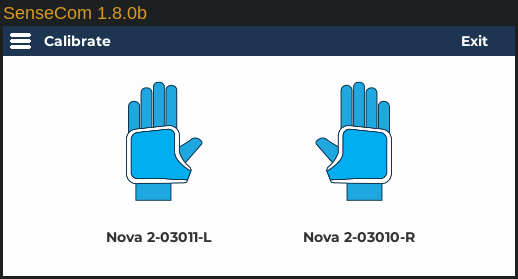SenseCom on GNU/Linux (Bluetooth Low Energy)
Follow these steps to quickly set up and run SenseCom on GNU/Linux:
- First, obtain the SenseCom binaries from its GitHub repository.
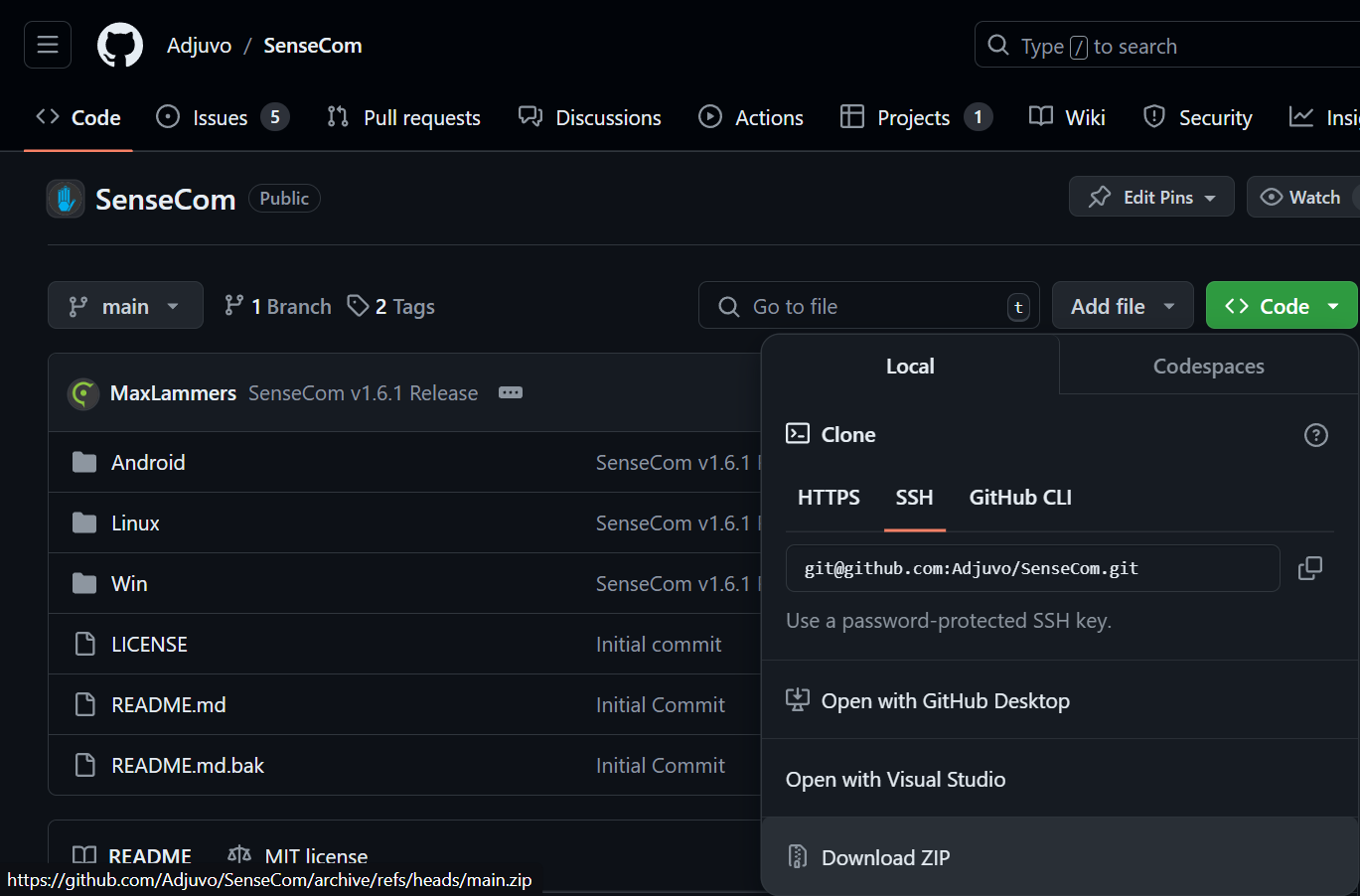
- Extract the SenseCom
.zipfile to a location on your computer.
$ unzip SenseCom-main.zip -d /some/path/
- Navigate to the
SenseCom_Linux_Latestfolder containing the SenseCom binaries for GNU/Linux:
$ cd /some/path/SenseCom-main/Linux/SenseCom_Linux_Latest/
- List the files and check the executable permissions for the main SenseCom binary,
SenseCom.x86_64:
$ ls -ahl
total 20M
drwxr-xr-x 3 mamadou mamadou 5 Apr 10 11:24 .
drwxr-xr-x 3 mamadou mamadou 5 Apr 10 11:24 ..
drwxr-xr-x 7 mamadou mamadou 34 Apr 10 11:24 SenseCom_Data
-rw-r--r-- 1 mamadou mamadou 15K Apr 10 11:24 SenseCom.x86_64
-rw-r--r-- 1 mamadou mamadou 33M Apr 10 11:24 UnityPlayer.so
- As seen above the
SenseCom.x86_64binary does not have the executable permission. Run the following command to set the executable permission for all users:
$ chmod a+x SenseCom.x86_64
- Veirfy the executable permission has been set on
SenseCom.x86_64:
$ ls -l SenseCom.x86_64
-rwxr-xr-x 1 mamadou mamadou 14720 Apr 10 11:24 SenseCom.x86_64
-
Make sure the glove is powered on.
-
Time to run the SenseCom executable:
$ ./SenseCom.x86_64
[UnityMemory] Configuration Parameters - Can be set up in boot.config
"memorysetup-bucket-allocator-granularity=16"
"memorysetup-bucket-allocator-bucket-count=8"
"memorysetup-bucket-allocator-block-size=4194304"
"memorysetup-bucket-allocator-block-count=1"
"memorysetup-main-allocator-block-size=16777216"
"memorysetup-thread-allocator-block-size=16777216"
"memorysetup-gfx-main-allocator-block-size=16777216"
"memorysetup-gfx-thread-allocator-block-size=16777216"
"memorysetup-cache-allocator-block-size=4194304"
"memorysetup-typetree-allocator-block-size=2097152"
"memorysetup-profiler-bucket-allocator-granularity=16"
"memorysetup-profiler-bucket-allocator-bucket-count=8"
"memorysetup-profiler-bucket-allocator-block-size=4194304"
"memorysetup-profiler-bucket-allocator-block-count=1"
"memorysetup-profiler-allocator-block-size=16777216"
"memorysetup-profiler-editor-allocator-block-size=1048576"
"memorysetup-temp-allocator-size-main=4194304"
"memorysetup-job-temp-allocator-block-size=2097152"
"memorysetup-job-temp-allocator-block-size-background=1048576"
"memorysetup-job-temp-allocator-reduction-small-platforms=262144"
"memorysetup-temp-allocator-size-background-worker=32768"
"memorysetup-temp-allocator-size-job-worker=262144"
"memorysetup-temp-allocator-size-preload-manager=262144"
"memorysetup-temp-allocator-size-nav-mesh-worker=65536"
"memorysetup-temp-allocator-size-audio-worker=65536"
"memorysetup-temp-allocator-size-cloud-worker=32768"
"memorysetup-temp-allocator-size-gfx=262144"
Loading in SingleInstance mode
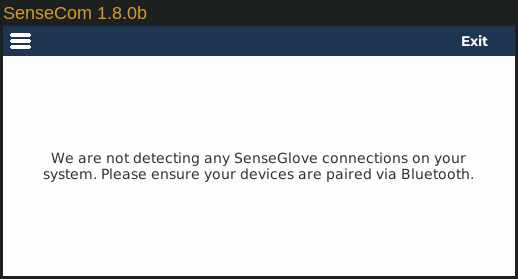
- After running SenseCom, it will not automatically connect to your gloves unless you have already paired them. To pair your devices, navigate to the hamburger menu and select
Pair Devices.
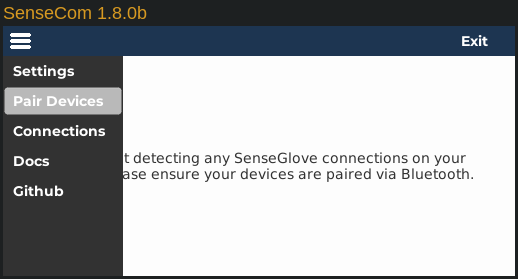
- Once inside the
Pair Devicessection, in case your gloves are already turned on, you should be able to spot them inside theNearby Deviceslist.

important
If SenseCom fails to recognize your gloves with Bluetooth Low Energy firmware,
it may be because the Legacy Connections option is enabled. In that case
SenseCom is only able to discover gloves with a Bluetooth Serial firmware.
Enabling this option should allow SenseCom to discover and connect to your
glove.
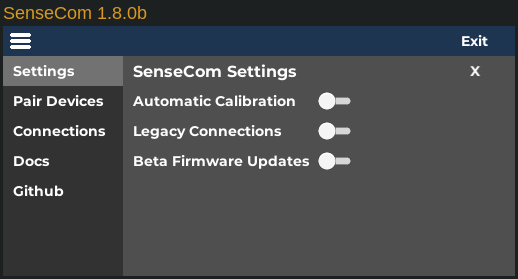
- Clicking on any glove within the
Nearby Deviceslist will prompt a pairing confirmation. If this is the desired glove you wish to pair, proceed by clicking theConfirmbutton.
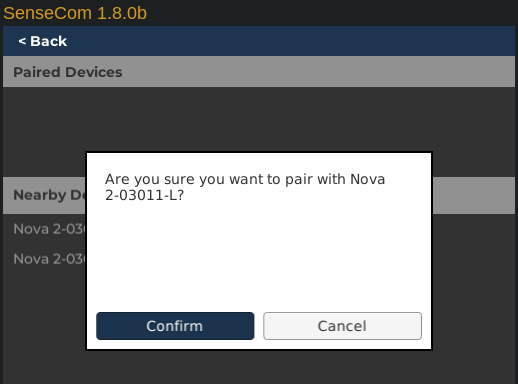
- After pairing all gloves, you can return to the main SenseCom window by pressing the
< Backbutton. If needed, you can always revisit thePaired Deviceslist to unpair any gloves.
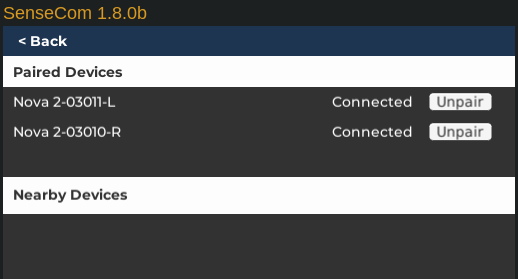
- If you have followed all the steps correctly, upon returning to the main SenseCom window, you should see that your gloves are connected
